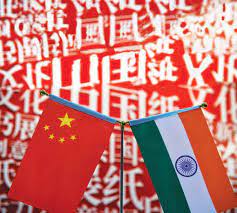The relationship between India and China is complex and has been a topic of much discussion and analysis over the past decade. Both countries are rising powers with regional and global ambitions, and their emergence has significant implications for the strategic order of South Asian regions and international politics. The rivalry gained traction among scholars and decision-makers in the last 60 years due to the legacy of hostilities between the two countries, especially the border skirmishes and the war of 1962. Both countries engaged in territorial disputes, had divergent political ideologies, and differing views on Tibet, nuclear non-proliferation policies and other bilateral issues.
The rise to power of China and India has been seen by some as a new “great game” in the making. This term refers to the competition for power and influence between imperial powers in Central Asia during the 19th and early 20th centuries. In the current context, it suggests that China and India are engaged in a struggle for dominance in Asia and beyond. The rivalry is based on several factors. Economic globalization has played a significant role, as both countries have benefited from increased economic growth and are competing for resources such as hydrocarbons and metals. In addition, as rising powers, both countries have developed a sense of entitlement. They are more protective of their assets, including water resources, which have contributed to the complexity of their relationship and the difficulty of resolving long-standing issues.
The strategies of China and India in dealing with each other have been influenced by their relative power and status. As the larger and more powerful of the two, China has sometimes been seen as “bossy” or assertive in its dealings with India. India, for its part, has sought to balance China’s power through alliances with other countries and by investing in its military capabilities. Despite efforts at border negotiations, confidence-building measures, and official dialogues, relations between China and India remain strained on several issues. These include the border dispute, Pakistan’s actions, the status of Tibet, and India’s admission to various international institutions. Bilateral trade and investment have also been a source of tension, as China has benefited disproportionately from these arrangements.
The factors that militate against unregulated competition between China and India include the risk of conflict, the potential for destabilizing alliances with other countries, and the need for cooperation on global issues such as climate change and humanitarian intervention. As both countries continue to rise in power and influence, it will be important for them to find ways to manage their differences and avoid escalating tensions.
The Sino-Indian rivalry has increasingly taken on a maritime dimension, with both countries building up and deploying their naval capabilities in the Indian Ocean Region (IOR) and Western Pacific. India is particularly concerned about China’s expanding bluewater naval capabilities, including submarines, and its access to ports in the region. Meanwhile, China is wary of India’s growing role in the Western Pacific and its perceived alignment with the US-led containment scheme, which allows it to leverage its partners’ bluewater assets.
Even though the seas are an ambiguous international medium, naval buildup and deployments have not necessarily shaped mutual perceptions between China and India as pure security seekers. Rather, the rivalry has its roots in unresolved terrestrial political problems, notably the land boundary dispute, over which a brief war was fought in 1962. Despite numerous talks, including the Special Representative talks, headway has yet to be made in resolving this dispute.
The Sino-Indian relationship can also impact regional integration efforts, such as SAARC, which has struggled to progress due to India-Pakistan tensions and China’s growing influence in the region. Furthermore, it can also affect global issues such as climate change, trade, and humanitarian intervention. Therefore, policymakers and scholars must continue to engage in dialogue and analysis to prevent any escalation of tensions and promote stability and cooperation in the region.
In order to manage the dispute, confidence-building measures such as the Border Defence Cooperation Agreement were instituted in 2013. While these measures have maintained stability, they have not eliminated the recurrence of incidents along the Line of Actual Control (LAC). In 2014, the Sino-Indian rivalry extended into the maritime realm when three Chinese naval ships sailed through the Lombok Strait, marking the first time a new route was charted from the South China Sea to the IOR, and conducted a drill. The war remains a remote prospect. The Sino-Indian rivalry at sea is likely to persist, given the longstanding host of unresolved problems between the two countries and their respective interests in the region. The Sino-Indian rivalry remains a significant factor in the Asia-Pacific region and beyond, with various economic, political, and security implications. The unresolved border dispute, leading to periodic clashes between the two countries, continues to be a source of tension. Additionally, India’s concerns over China’s expanding naval presence in the Indian Ocean, particularly its access to ports, have added a maritime dimension to the rivalry.
While India has engaged with China on various bilateral issues, it has been cautious about engaging on larger regional security issues. India’s diplomacy has been focused primarily on bilateral engagement with its neighbours and major powers rather than forging broader regional partnerships to address shared challenges such as terrorism and instability in Afghanistan. The May 2020 border skirmishes and subsequent tensions have further inflamed public opinion in India and led to measures such as the banning of Chinese mobile apps and closer ties with Quad partners. The future trajectory of the Sino-Indian rivalry remains uncertain, but the rivalry will continue to shape the region’s dynamics for the foreseeable future. This competition for influence has resulted in several challenges and opportunities for South Asian countries. On the one hand, they have been able to leverage the economic growth of China and India for their development. Still, on the other hand, they have been drawn into the strategic competition between the two powers.
China has been expanding its economic and diplomatic engagement with South Asian countries through the Belt and Road Initiative (BRI), which seeks to build infrastructure and deepen economic integration. However, this has also raised concerns about China’s strategic intentions, particularly in countries like Sri Lanka and Pakistan, where China has invested heavily in infrastructure projects that some fear could be used for military purposes. India, for its part, has sought to counter China’s influence in the region through various diplomatic and economic initiatives. The Indian Ocean Rim Association (IORA), for example, seeks to promote regional economic cooperation and maritime security. At the same time, the South Asian Association for Regional Cooperation (SAARC) aims to promote regional integration among South Asian countries.
India has also sought to deepen its military and strategic ties with South Asian countries, particularly those concerned about China’s rising power. The competition between China and India in South Asia will likely persist and significantly affect the region’s economic, political, and security landscape. The challenge for South Asian countries will be to navigate this complex strategic environment while pursuing their own economic and development goals. Indeed, the Sino-Indian relationship has implications beyond the two countries themselves. As two of the world’s most populous nations, their actions can significantly impact global politics, economics, and security. Their rivalry and competition for influence can affect the stability of the Asia-Pacific region, where both countries have a significant presence.
The Sino-Indian relationship can also impact regional integration efforts, such as SAARC, which has struggled to progress due to India-Pakistan tensions and China’s growing influence in the region. Furthermore, it can also affect global issues such as climate change, trade, and humanitarian intervention. Therefore, policymakers and scholars must continue to engage in dialogue and analysis to prevent any escalation of tensions and promote stability and cooperation in the region.






















